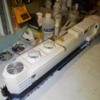I didn't want to cloud a post in the 3 rail forum with another problem. I have a USA trains GP30 G scale engine, that someone else converted to PS2. It has all the stock PS2 guts inside and even MTH trucks. It has always run fast. It runs faster than any other MTH G scale engine I have and won't go in a lashup with any other engine. I have swapped sound files, swapped tach readers, I've cleaned the flywheel which even has painted on MTH stripes. It was the first release of G scale Amtrak Dash 8. It still ran fast. About five scale MPH too fast.
So when I was running it and it started acting up, I figured something in the board was finally failing.
I narrowed a problem down to a dead short in one truck across the wheels and pickups. I noticed that if the bottom removable plastic cover is tightened to much, there's a dead short inside. Sounds easy to find, but I haven't gone farther. I left the cover screws snug and all was well?? It ran good when I ran it.
Fast forward a few months and I took it off the shelf to run with a new G scale conversion I was doing that must have had a wrong tach tape because it also was running fast. I paced the two engines a foot apart and they ran in sync. Then the GP30 at first slammed to a stop. I restarted it and it ran again in pace with the other. I was about to couple them together when I lost all control of this GP30. It ran silent at the speed it was last running after bucking a bit? It stopped quickly resumed to speed and repeated. It seemed like it wasn't getting the speed command correctly.
I figured the engine's trucks must be shorting again. I fired the engine up one more time to see if the board was fried because I couldn't detect a short. It fired back up as if the board had recovered again. I have not run it since.
So.........shweeew. I'm tired of typing.
I figure the only proper thing is to remove the board and test it in another engine? or Should I send it out for safety of the board? Sound like a different component failing? If I install it in a known good engine, I might expect to solve the issue????
I always thought this board had an issue because of the speed difference. When the truck is shorted, it trips the breaker because the short is dead across the wheels. The breaker never tripped??








